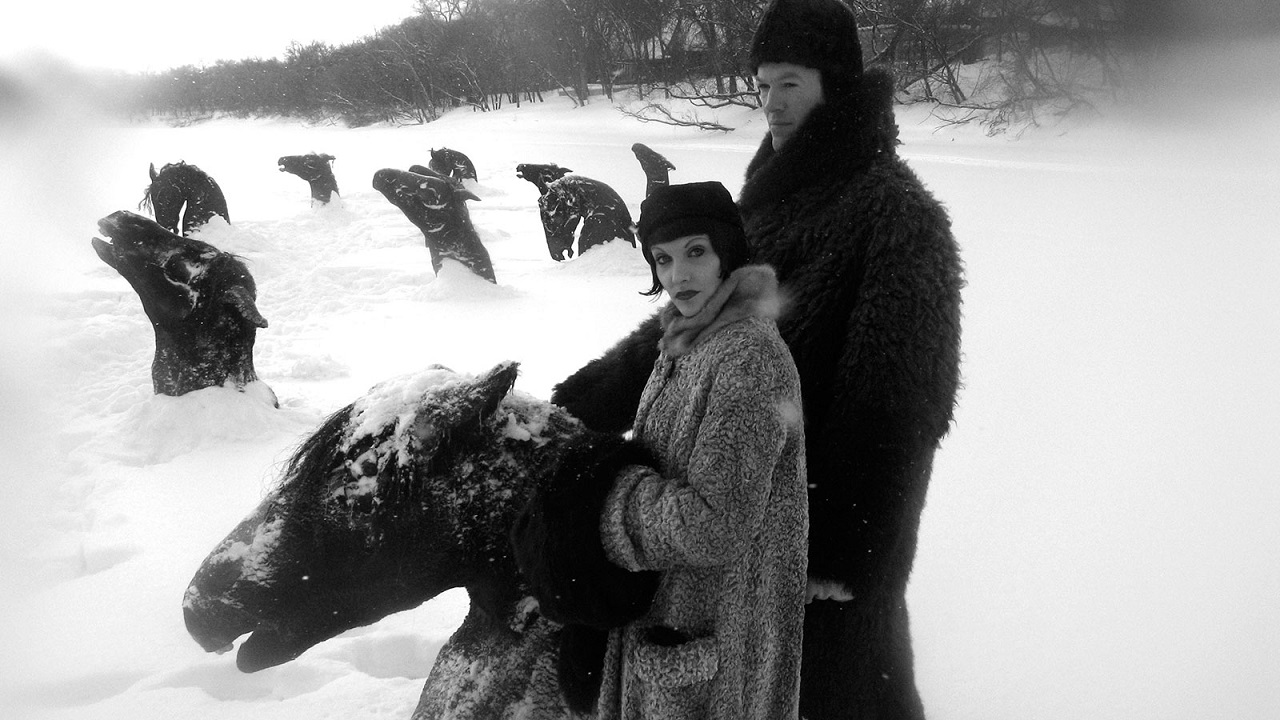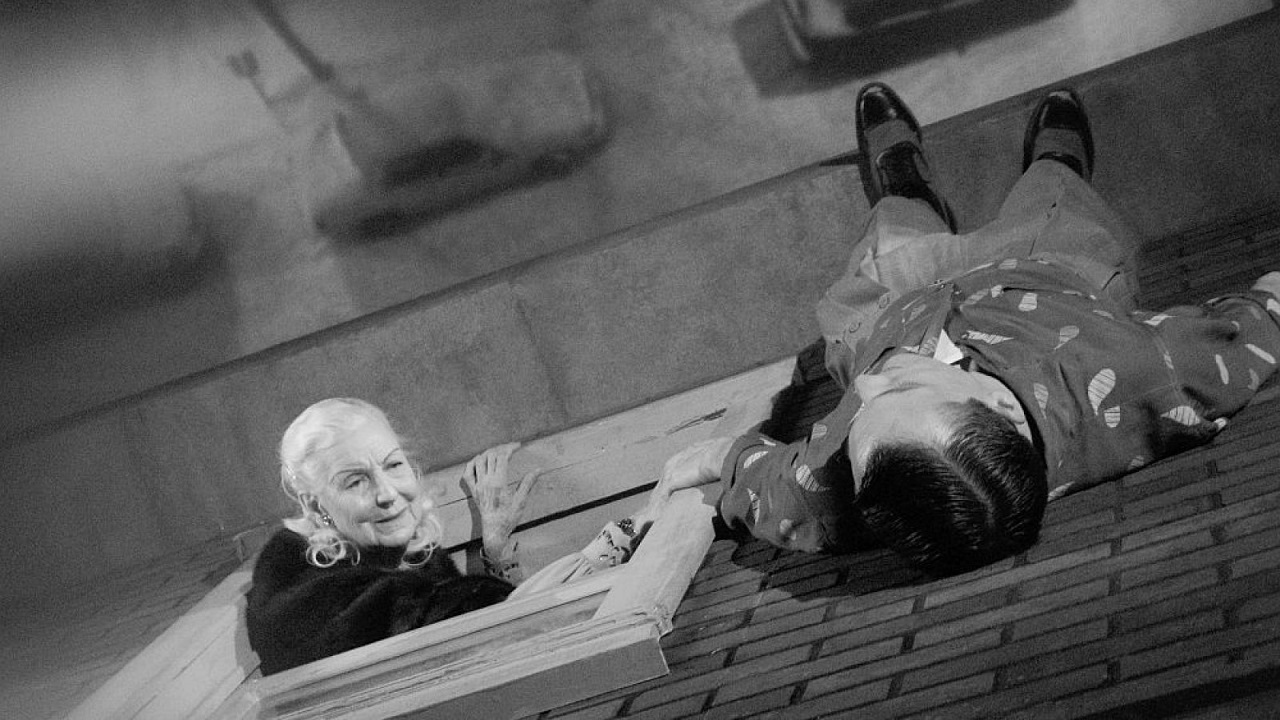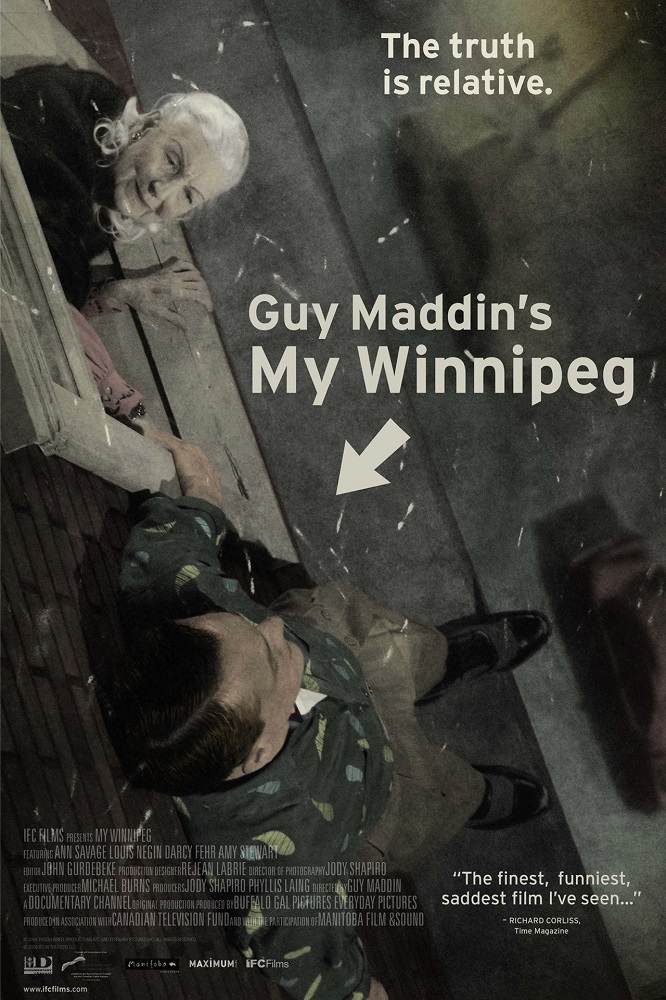Crew
Director/Conceived by Guy Maddin, Dialogue – George Toles, Producers – Phyllis Laing, Guy Maddin & Jody Shapiro, Photography (b&w + some scenes colour) – Jody Shapiro, Animation – Andy Smetaknak, Production Design – Rejean Labrie. Production Company – Documentary Channel/Buffalo Gal Pictures/Everyday Pictures.
Cast
Narrator: Guy Maddin. Ann Savage (Mother), Darcy Fehr (Guy Maddin), Amy Stewart (Janet Maddin), Louis Negin (Mayor Cornish), Kate Yacula (Citizen Girl)
Plot
Filmmaker Guy Maddin makes a documentary about his hometown of Winnipeg. He attempts to explore the reasons why he cannot leave Winnipeg in the hope that he can. He sees that Winnipeggers live in a permanent sleepwalking dream where their city is imprinted in the unconscious. In trying to seek answers, he decides to make a film about several events from his own childhood, casting his mother as herself and using other actors to play himself and his siblings, while renting out the house he grew up in in which to shoot.
Guy Maddin is one of the most unique filmmakers in the world. Through films like Tales from the Gimli Hospital (1988), Archangel (1990), Careful (1992), Twilight of the Ice Nymphs (1997), Dracula: Pages from a Virgin’s Diary (2002), The Saddest Music in the World (2003), Cowards Bend the Knee, or the Blue Hands (2003), Brand Upon the Brain! (2006), Keyhole (2011), The Forbidden Room (2015), The Green Fog (2017) and as co-director of Rumours (2024), Maddin has charted out a unique niche for himself. Guy Maddin’s films are comprised of surrealistic deadpan kitsch, improbably melodramatic plots and stylistic homages to a form of lost cinema – most notably German Expressionism and silent movie-making. (Guy Maddin is surely the only person alive who still makes actual silent movies).
One of the distinctive quirks about Guy Maddin is that he makes all of his films in his hometown of Winnipeg, Manitoba, having only ventured forth to the USA to film for the first time in 2006 with Brand Upon the Brain!. Ostensibly, My Winnipeg was a work made for the Documentary Channel where Maddin explores his hometown and his relationship to it, partially through the town’s history and partially by looking at his own childhood.
At face value, My Winnipeg is a documentary and should have no place on this site, which is dedicated to fantasy and the surreal. On the other hand, Guy Maddin conflates what should be a standard documentary into something entirely surreal that at the same time as it covers the same places as a standard geo-ethnic biography might also becomes a dream-like quest where real details of Winnipeg’s history blur into one big shaggy dog story that Maddin is pulling on us. The result is a work that behind the lip-service of a documentary is something as fantastical as Guy Maddin’s outrightly surrealistic depiction of Winnipeg in The Saddest Music in the World.

Without being a native Winnipegger, it is hard to work out what parts of the story are true and at what point Guy Maddin is pulling our leg. Some aspects of the film are undeniably true – the General Strike of 1919, the demolition of Eaton’s Store and replacement by a stadium, the demolition of the Winnipeg Arena – and parts that have enough face-value plausibility that you wonder if they might be true – the ladies who handcuffed themselves to a tree to prevent its demolition, or where the city staged an imaginary Nazi invasion as part of a drive for war bonds.
These sit also alongside parts of the film where Maddin is slyly indulging his fanciful imagination – stories of horses that fell into a lake, which then froze over with their heads protruding out of the ice and became a local lover’s retreat; claims that Winnipeg has the greatest number of sleepwalkers in the world such that the city has had to enact laws requiring home-owners to let any sleepwalkers that end up at their homes to spend the night; or stories about secret arterial back routes through the city and wars between taxi companies over the ownership of these; claims that Maddin’s mother was the lead actress of Winnipeg’s only native tv series entitled The Ledgeman about a man who ends up about the jump off an apartment ledge each week until he is persuaded down by his mother.
At other times, Maddin drops the shaggy dog stories and vents unadorned vituperation at the politics of Manitoban major league ice hockey, the demolition of the arena that holds a great deal of his childhood memory and the replacement of a city landmark with a white elephant arena that he scathingly likens to a “zombie in a new suit”.

In the last few of his films, Guy Maddin has begun to blend fiction with a peculiar quasi-autobiographical subtext – both Cowards Bend the Knee and Brand Upon the Brain feature heroes named Guy Maddin, for instance. Cowards Bend the Knee wound many of Maddin’s autobiographical details into a highly fictionalised story. Overbearing mother figures also feature in most of Maddin’s films. This reaches an apotheosis in My Winnipeg where Maddin went and (supposedly) rented several rooms of the home where he grew up and then hired actors to play himself, his mother and siblings in recreations of several events from his childhood. It is these scenes that come the closest to the hysterical melodramatic deadpan of Maddin’s fictional films – like the decision to represent his father as a corpse covered by the carpet in the middle of the room and to keep an elderly woman there because she lived in the house and wouldn’t go away.
Everything is wrapped up by Maddin who also acts as the film’s narrator. Uniquely, Maddin frames the film in terms of his own quest to escape from Winnipeg, constantly asking the question of what it is that keeps him imprisoned there. There is much in the way of flashbacks to scenes of an actor standing in for a sleeping/dreaming Maddin on a train constantly travelling through the back-projected streets as he tries to wake up.
Throughout Maddin’s narration comes in a stream-of-consciousness, frequently made up of staccato, single-word sentences. Here Maddin is constantly conflating metaphors and similes, both preposterous and powerful, and fusing imagery (like that of the river Forks that the city lies on with imagery of a pair of naked female thighs). The result is a documentary that takes place as a stunning frozen dream-like fugue, the conjuration of a world that seems as much dreamed as it is real.
(Winner in this site’s Top 10 Films of 2007 list).


